Naguib Mahfouz
Article

Naguib Mahfouz – The Son of Two Civilizations
by Anders Hallengren*
This article was published on 16 October 2003.
“I am the son of two civilizations that at a certain age in history have formed a happy marriage. The first of these, seven thousand years old, is the Pharaonic civilization; the second, one thousand four hundred years old, is the Islamic civilization.” – Naguib Mahfouz, Nobel Lecture
The Arabic Renaissance and the Rise of the Egyptian Novel
Arabic literature can be traced back almost two thousand years. Poetry has always been its most prominent genre, but there is also an ancient tradition of narrative that expresses itself in a wealth of different oral forms. In Egypt, the collection of stories called The Arabian Nights, a series of tales of Indian, Iranian, and Iraqi origin, was brought to its final and most developed form. This coincided with an ancient Egyptian tradition of storytelling which has remained vivid and alive to this day, the public storyteller having been a cultural institution for ages.
The birth of the Egyptian novel, however, could not take place until the modern era, when five preconditions had been fulfilled: 1) the influence of European literature, where the novel developed into a major genre in the eighteenth and nineteenth centuries; 2) the establishment of Egyptian printing works and pressrooms in the nineteenth century along with the rise of newspaper production; 3) public education and the spread of literacy; 4) a gradual liberation from oppression by foreign powers, starting with the reign of Muhammad Ali in the aftermath of the Napoleonic occupation in the early 1800s; and 5) the emergence of an intellectual class with broad international learning.
Thus an Arabic Renaissance finally arose; its Janus face turned as much to the past as to the future. The concept of Nahdah in Arabic literary criticism and historiography, meaning a “rising up” or revitalisation, refers in part to a period of neo-classicism, an awakening of old literary traditions following a time of decline or stagnation since the eleventh century. The term also refers to creativity, new syntheses, modernisation, dynamic experiments, and progress (– as described by, for instance, J. Brugman in An Introduction to the History of Modern Arabic Literature in Egypt, Leiden: E. J. Brill, 1984, Ch. “The Nahdah”). The Egyptian novel matured in great works by twentieth century writers such as Muhammad Husayn Haykal (1888-1956), Taha Husayn (1889-1973), Ibrahim al-Mazini (1890-1949), Mahmud Tahir Lashin (1894-1954), and Tawfiq al-Hakim (1898-1987).
Muhammad Husayn Haykal’s novel Zaynab, published in 1912, is often regarded as the first true Arabic novel, but there were many forerunners. The most important successor, however, was born about the time of the completion of Husayn Haykal’s work. The development of the modern Egyptian novel is reflected by – and reaches a peak in – the half century of work by Naguib Mahfouz, Nobel Laureate in 1988, the first writer in Arabic to receive the Nobel Prize in Literature.
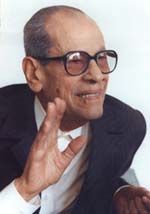
Naguib Mahfouz, 1988 Nobel Laureate in Literature
Photo: Mohamed Hegazy
Mahfouz’s Perennial Quest
Many Egyptians know the stories by Mahfouz from the cinema. This fact brings the central facets of the continuation of the so-called Renaissance into immediate focus. The introduction of new genres and new media provided new means of expression, reflection, and creativity, and, in the opposite direction, influenced the creators of literary arts and genres as well as society as a whole. Taking an active part in the Egyptian film industry, both as an official and as a producer of manuscripts, Mahfouz is also part and parcel of a modernisation process that comprises the leading film-producing country in the Arab world. The Egyptian film industry is, next to that of the U.S.A. and India, the largest in the world.
The development of his writings is also connected with the constantly growing importance of news media, magazines, daily papers since Mahfouz himself is, for example, a contributor to and reader of the Cairo newspaper Al-Ahram (The Pyramids), founded in 1875.
In Layali alf layla (1982), translated as Arabian Nights and Days, Mahfouz, adopting the story telling fashion of The Arabian Nights, writes riddles which can be read against the background of contemporary politics and society, in particular perhaps the open-door policy introduced by President Sadat. Using the traditional types – ruler, ruled, the mystic guide, the secret connection – his tales are open to various interpretations. They are principally stories of good and evil, right and wrong, truth and betrayal, which make them of universal concern. They tell us of dreams and teach manners, as tradition has always done. Ultimately this collection of stories has, like classical fables, a moral status. However, the author is never a fabulist in any other sense, but looks upon himself as having a mission and a deep responsibility as a writer. In a way, Naguib Mahfouz seems to have taken the place of honour among ancient Egyptian scribes. As in the Teaching of Cheti, probably from the twelfth dynasty, in which books are praised as being “of superior value”, as essential “as water”, the writer has a moral calling. Even the Arabic word for literature, adab, originally refers to a high level of culture, i.e., good behaviour and exalted manners. Novels (rumaniyat) were originally also accepted and developed for the teaching of adab. The best-known stories by Mahfouz depict the lives and manners of lower middle-class families in Cairo and their environment. In particular, he tells us about the alleys of the El Gamaleya area (al-Jamaliyya), the neighbourhood in which he spent his childhood and youth.
To see his works as mainly political fables or allegories is fallacious. It is a most misleading simplification, since there are many levels of interpretation and reception. His novels and short stories are works of art. They picture Egyptian milieus from the most ancient of times to contemporary everyday life, deal with questions of broad human concern, raise philosophical and existential questions. The author is always guided by a belief in Egyptian continuity and greatness, from time to time shaken to its foundations by tumultuous history, the corruption of thought and disaster. In his novels there is a staunch belief in moral right and a constant seeking for Egyptian identity behind the weft of illusion and reality. A dweller in truth, unable to define it, Mahfouz is – like the investigator, Meriamun, in his novel on the enigmatic Akhenaten – perpetually pursuing his own self.
In the narrative stream of his short stories and his novels, the reader encounters a great variety of characters, people described as soon as they appear before us (or the other way round). They leave lasting impressions but also hold back something essential that does not come within our grasp. They turn up and disappear, leaving traces and clues, but remain enigmatic, ambiguous. They are figures in a greater story, or pieces in a puzzle, that is the œuvre of Mahfouz. Their lives are texts, continually being written and rewritten, as is Egyptian history. Their appearance changes as the context alters with time and setting. Likewise their meaning and purport depend upon viewpoint and perspective, and there are many layers of interpretation, from the gross to the subtle and inexpressible. A correct hermeneutics or a right understanding is as evasive as al-sarab, the mirage of al-sahra, the nothingness of a vast expanse of desert. So do human illusions appear before us, materialise, and fade away, leaving voids pregnant with meaning.
The Pertinence of the Past
Naguib Mahfouz started his career as a writer by exploring ancient Egyptian history. He did not do so to understand the contemporary scene, still less was it to criticise it in a covert fashion. His aim was to seek the identity of his own country in the space-time of his existence and the sphere of his Self. He also obviously sought for a reliable anchorage in the distant past during years of war, upheaval, and calamity. Being an Arabic author, he transcends the limits of Arabic and Moslem tradition, to which he belongs, tracing his heritage and seeking his identity as an Egyptian.
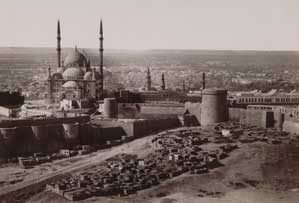 |
| Old Cairo, scene of many of Mahfouz’s novels and short stories. Photo: The Royal Library, National Library of Sweden |
His first published book was a translation of James Baikie’s concise history of Ancient Egypt (Misr Al-Qadimah, 1932), published by the periodical Al-Majalah Al-Jadidah (The New Magazine). Between 1939-1945, that is, during the years of the Second World War, he published three novels about ancient Egypt. His first published novel ‘Abath al-Aqdar (1939), “Ironies of Fate”, dealing with “the malediction of Ra”, was followed by two other historical novels about ancient Egypt. It was the beginning of a gigantic plan for forty projected novels. The author’s aim was to employ the novel form to relate the history of Egypt from the earliest times up to his own day. However, writing about the past, he found himself writing about the present. Then he turned to the life of modern Egyptians, first of all to those in his own Cairo quarters. Later on he was to find that when writing about the present he was also writing about the past. It is no mere coincidence that he returns to the perspective of ancient Egypt in novels written in the 1980s, forty years later. In a way, the history of Egypt from past to present is the framework of all his writing.
The ‘Abath al-Aqdar (1939), is based on an ancient Egyptian legend. Originally the novel was entitled Hikmat Khufu, “The Wisdom of Cheops”. This pharaoh, who lived about 2680 BC, during the fourth dynasty of the Old Kingdom, has been told by a soothsayer that after his death, his son will not inherit the kingdom. Instead, it will fall in the hands of Dedef, the son of the high priest of the temple of Ra. Cheops consequently takes every measure to change the future. In this drama of confusion, as intricate as the fate of King Oedipus and the legend of Moses, all attempts to interfere with destiny prove to be in vain.
It is notable that when the author later on turns to social and contemporary issues, something of this early belief in fate, destiny, dispensation or providence remains. People in his novels are often, like reeds in the wind, almost powerless in the face of circumstance and chance.
The second historical novel, Radubis (1943), is a story about a courtesan in ancient Egypt, and is named after her. She is the lover and mistress of the Pharaoh Mernere II, and the novel is about the romance between them. Not much is known about kings called Merenre or Mernere in the most ancient list of kings; we hardly know more about this king than that he ruled for a year at the end of the sixth dynasty, and that there was a queen Nitocris at the time, famous for her beauty. These facts make the subject different from the first novel, giving imagination an even freer rein. The love between the pharaoh and the courtesan Radubis is a pure love of devotion. The gods sanction it, and at last he gives up all resistance, driven by forces beyond his control. Finally, he uses the assets of the country to celebrate the wonderful woman who captivated the heart of the pharaoh by means of divine forces.
In his book about the Hyksos wars, the author turns his attention to the decline and fall of the Middle Kingdom during its last period (1785-1575 BC). Kifah Tiba (1944), “The Struggle of Thebes”, describes the wars against a foreign power of Asiatic origin which ruled over Egypt for a long time. It is a story of the end of an era. But when the Hyksos were finally expelled, Egypt became independent and began building a new and prosperous empire, The New Kingdom. The historical framework is itself a story of archetypal dimensions. Mahfouz is writing about a renaissance, the rise of Egyptian nationalism, the fight for independence and regained self-confidence reflected in his own times, as many times before.
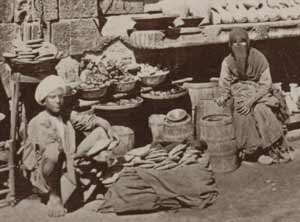
Mahfouz’s novels and short stories are works of art, picturing milieus from the most ancient of times to contemporary everyday life. Photo shows vendors selling their wares in the streets of Old Cairo.
Photo: The Royal Library, National Library of Sweden
Power and Social Issues
The series of historical books was followed by records of modern Cairo, the Khan al-Khalili (1945), the author turning abruptly but quite naturally to his own era. The novel describes the life and final tragedy of a family which, during the war, was forced to move to a less fashionable part of the city. The narrator-seeker walks freely and unhindered, as it were, in the same places in different times, sensing continuity, in pursuit of the red thread in the story that is made up by history and in which he is himself a part.
In many of the novels by Mahfouz, women play a central part. Western critics have sometimes remarked that novels are built up round women who can match the men in the narrative, and there are many of them in the Egyptian novels. In Mahfouz’s works, prostitutes and other fallen females are often the strongest and the wisest characters. Mothers and other women constitute a secret net of devotion, passion, and care that holds the chaotic world of men together. The author’s sympathy is with the oppressed and the miserable, with the weak and the loving. Women are often viewed as victims, as the victims of cruel circumstances, even when they are blamed and mocked. And that is true of men, too.
After the Khan al-Khalili, named after a working class area, he wrote Zuqaq al-midaqq (1947), “Midaq Alley”, named in a similar fashion after a street in Cairo. The main character is a lower-class woman during the Second World War. A hairdresser is madly in love with her, but the open-handed British soldiers in the city also tempt her. Her Egyptian lover is finally crushed by unhappy love and jealousy, and she ends up as a lady of the night.
A special portrait of motherhood was presented in the next novel belonging to this socially concerned and realistic series of contemporary novels leading up to the Cairo Trilogy. Al-Sarab (1948), “The Mirage”, tells about the crucial point where maternal instincts, motherly love and mother-fixation intersect. It is a psychological novel but, as many times before and afterwards, issues of fate, destiny and free will are raised but not answered. There is shame, but there is no guilt.
A mother who cannot let her son go after her husband/his father has left her, brings up the protagonist. He is the apple of her eye, and there is no lack of love during the years when he is growing up. He is unhappy and miserable at school and at the university, however, and he gets an insignificant government post. He marries, but cannot establish a good relation with his wife, who is unfaithful, she has a love affair, and dies after an abortion. When he finally dares to revolt against his mother and reproaches her, arguing with her for the first time, she dies of a heart attack.
Power and decline is the theme of many novels and stories about old and modern Cairo, including the realistic masterpiece that brought the author universal fame and the Nobel Prize, the Cairo Trilogy (al-Thulathiyya, 1956-1957):
Bayn al-qasrayn (1956), “Palace Walk”
Qasr al-shawq (1957), “Palace of Desire”
al-Sukkariya (1957), “Sugar Street”
 |
| Western critics have sometimes remarked that novels are built up around women who can match the men in the narrative. Photo: Anders Hallengren |
The shadow of a dominant father, al-Sayyid Abd al-Jawad, falls over three generations of an ordinary Cairo family, whose fate and strivings we follow over the first part of the twentieth century. In this comprehensive family saga in three parts (the second of its kind in Egyptian literature after Taha Husayn’s book about another family tree of misery, Shajarat al-bu’s (1944), different streams in contemporary Egypt are reflected in individual preferences and attempts at liberation among the siblings. These attempts include hedonism, intellectual life, communism as well as fundamentalist Islam. The novels present a variety of outlooks from a local perspective, as does the work of Mahfouz as a whole. We get to know a genuine Cairo environment, are introduced to the private life both of an oppressed wife who is the source of love and care, and her closely guarded daughters. There are three very divergent sons, heading in opposite directions and in increasingly rebellious ways, as eventually the grandsons also do, though in an even more radical manner. The dignity or karâma of the father and the tradition, alongside the guidance of women, in a way holds the narrative as well as the family together. This is the basis of continuity as well as of opposition during the turbulent times of English occupation, and the constant confrontation of Occidental and Oriental values.
The Children of Gebelawi
In actual fact, a similar theme runs through Awlad haratina (“Children of our quarter”, 1959; translated as Children of Gebelawi), which created the greatest stir in Mahfouz’s life, and determined his fate in a violent way.
When the rich and powerful Gebelawi banishes his children he casts a spell on his family in doing so, as if he were expelling them from the Garden of Eden. Patriarchal power determines their fate in this very complex narrative, where the incomprehensible main character has withdrawn from the scene and retreated to the house that can be seen at a distance. That is the closed core of all events, the invisible force in an expansive web of life.
In his novel, Mahfouz in a way writes a history of humankind up to the 1950s, starting with the Dawn of Creation. At the same time, it is a story about children in a Cairo suburb and their difficulties. For his narrative he has drawn on – or sometimes paraphrased – Al-Qur’an and the traditional Islamic Hadith literature for many figures and events, freely transforming them and inserting them into a new historical and completely fictional context. Leading characters in the novel were early identified as religious figures: Gebelawi (Jabalawi) himself has been identified as God (Allah), the Almighty Creator and Supreme Being. Similarly other main characters like Idris, Adham, Jabal, Rifa’a, Qasim, and ‘Arafa have been seen as representing or symbolising Satan, Moses, the prophets Jesus and Muhammad, and modern science respectively. But the framework and the environment is a local area on the outskirts of Cairo at the foot of the Moqattam Hills, in a small-town atmosphere of family quarrels, hopes, and cares. Some inhabitants fear or follow local chiefs (politics?), whereas others turn to higher ideals (religion?).
When Awlad haratina was serialised in the Cairo newspaper Al-Ahram 1959, leaders of the Islamic university Al-Azhar, the custodian of faith and morals, called for the banishment of the ‘heretical’ book, and crowds of people marched on the streets to the big Al-Ahram building shouting their protests against the blasphemous book by Naguib Mahfouz. The ban was never officially sanctioned, the serialisation did not stop, but the novel was only published abroad in book form. In her well-informed dissertation, The Limits of Freedom of Speech: Prose Literature and Prose Writers in Egypt under Nasser and Sadat (Stockholm University, 1993), Marina Stagh showed the secret forces at work behind this public drama, and the final agreement reached between the author and the government in this affair. Today, there is no official ban on this book, and in fact, there never has been.
However, the publication of Salman Rushdie’s The Satanic Verses in 1988, famous as well as infamous for its international consequences, raised the almost thirty-year old question of Mahfouz’s blasphemy and his alleged undermining of the dignity of the Prophets. Suddenly Naguib Mahfouz found himself paired with a foreign author with whom he had nothing in common. Himself a pious Moslem believer, an author of international repute and learning and an earnest moralist, he felt obliged officially to defend Rushdie and the freedom of speech as a holy right of humanity. This made some of Rushdie’s enemies compare The Satanic Verses to the Children of Gebelawi, concluding that a similar fatwa should have been pronounced on Mahfouz, too.
Naguib Mahfouz then summarised his moderate and very measured standpoint in this way:
“I have condemned Khomeini’s fatwa to kill Salman Rushdie as a breach of international relations and as an assault on Islam as we know it in the era of apostasy. I believe that the wrong done by Khomeini towards Islam and the Muslims is no less than that done by the author himself. As regards freedom of expression, I have said that it must be considered sacred and that thought can only be corrected by counter-thought. During the debate, I supported the boycott of the book as a means of maintaining social peace, granted that such a decision would not be used as a pretext to constrain thought.” (Al-Ahram, 2 March, 1989; for a detailed account see Samia Mehrez, “Respected Sir”, in: Michael Beard and Adnan Haydar, eds., Naguib Mahfouz: From Regional Fame to Global Recognition, Syracuse, UP, 1993.)
This did not finally settle the matter, however; nor could the stigma and the suspicion ever be effaced. The Egyptian Government offered the bigoted “infidel” (kafir) protection, but the author always refused, keeping to the simple routines of his private life in Cairo. One day in October 1994, however, on one of his regular visits to the Qasr Al Nil café, an attempt was made on his life by a follower of al-Jihad, the same religious group that assassinated Sadat. He was stabbed in his neck with a knife and was seriously injured, but survived.
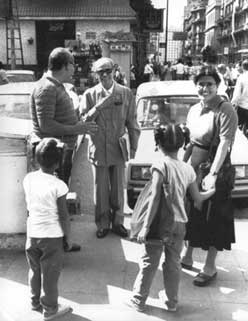
Mahfouz (center) chatting with admirers in Cairo.
Photo: Pressens Bild
The Enigmatic and the Absurd
It is easy, all too easy, to descry literary traces of the chaotic world of his life and times. There are many stories of modern decline and lack of order and confidence, but they are also literary experiments in modern prose genres.
In Tharthara fawq al-Nil (translated as Adrift on the Nile), 1966, a complete opposite to Meriamun’s floating along the Nile in Dweller in Truth, we are on a house-boat on the Nile among disillusioned and cynical gamblers, loafers and addicts. The government official, Anis Zaki, who has lost his wife and his daughters, is the centre of a whirl of frustrated talk and passivity. He and his friends are involved in a fatal accident where a peasant is killed, but they let the matter rest there. In the Alexandria novel Miramar (1967), set in the early 1950s, a maid, Zahra, attracts the attention of a number of men in the neighbourhood. Different narrators tell different stories in this little drama, which mirrors the various current political and social views of the revolutionary years. The author shows a complex setting, but does not supply us with a key to show us how to interpret the set of narratives. Taht al-Mizalla (“Under the [bus] Shelter”) is a collection of short stories from 1969. In the title story, we are presented with a crowd of people at a bus stop, waiting, watching. The most horrifying and upsetting things happen before their eyes while they are standing there, odd occurrences and violent accidents to which they are passive witnesses. We do not know what they think, nor do we know the meaning of the scene. It is like a late surrealistic film by Luis Buñuel or an absurd drama by Eugène Ionesco. In Hadrat al-Muhtaram, “Respected Sir” (1975), Mahfouz satirically portrays a civil servant and government employee, ‘Utman Bayyumi, in which he most probably also ironically portrays himself as an aspiring official, a part of the system and the class he satirises.
The Court of Osiris
The author’s concern with power is obvious, but his main question is the following: What have the leaders of Egypt – pharaohs, sultans, khedives, kings, presidents, fathers, invaders, occupants – done for (or done to) his country? In this comparative study of politics, focused both on the past and on the present, parallels and repetitions stand out, and the observer seems to behold an eternal return of decline and fall, nationally as well as individually. He does not hesitate to let the high and the mighty confront each other, and there are some extreme and highly controversial examples of this feature.
In Amam al’arsh (“Before the Throne”), published in 1983, Egyptian leaders of different eras are assembled and committed for trial at a court. The justice in this Supreme Court is the sun god Osiris, sitting on his throne. The goddess Isis and their son, falcon-headed Horus, assisting him, sits by his side. It is like a scene from the ancient Egyptian The Book of the Dead, written in hieroglyphs. That is the manual for the dead, a guide-book for those who are about to be tried by the eternal court, a fragmentary “book” that has been found in scrolls and mural paintings in tombs throughout the country.
Now the court of Osiris is going to judge the rulers of Egypt, from the founding father of the country, Menes (the Pharaoh Narmer, who united Upper and Lower Egypt five thousand years ago) through the Ottoman rulers down to Anwar al-Sadat, killed in 1981, shortly before the novel was written. Pre-Arabic history thus blends and intertwines with Islamic history and contemporary politics. The author perceives, or tries to establish, a deeply felt continuity. Sticking to his identity as an inhabitant of Old Cairo, al-Qahirah, he has also publicly objected to various kinds of pan-Arabic movements in the Muslim world, stressing that the Al-Azhar mosque and university in his vicinity is the centre of the teaching of sunnah. Being the child of two civilisations, the Egyptian civilisation is as important to him as the Islamic one.
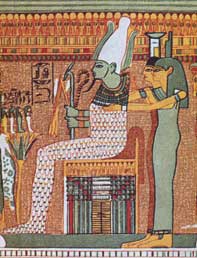 |
| Osiris throned within a shrine. From the Papyrus of Ani (Brit. Mus. No. 10, 470, sheets 3 and 4) |
In the crowded court room where the voices of poets, khedives, Sufi women, patriarchs, kings, pharaohs, presidents, courtiers and many others are heard, examination and interrogation sometimes turn into heated accusations and debates, since the defendants partake in the trial of the accused. From the 19th dynasty (1308-1186 BC), a period of military campaigns against Hittites and others, strong domination, and the building of great temples in Abu Simbel, Karnak, Luxor and Thebes, the Pharaoh Rameses II appears. After being questioned, he compliments his late successor, the revolutionary Gamal Abd el-Nasser.
Nasser seized power in 1956 after the overthrow of King Faruq in 1952 and the abolition of the monarchy in 1953, when the Republic of Egypt was proclaimed. The ancient king’s admiration of the republican may in part be the author’s assessment of Nasser, emphasising parallels between the two characters. Judge Osiris furthermore points out that President Nasser was the first ruler to care for his people. But Rameses II, the ruler of an empire, blames Nasser for reducing Egypt to an insignificant state, and the founder of Egypt, the Pharaoh Menes, chimes in accusing Nasser of having let the features of majestic Egypt dissolve into the vague outlines of Arabism.
Nasser, in his turn, attacks his successor, Anwar al-Sadat, for having destroyed the country by his open door-policy, the infitah, “opening up” of Egypt, leaving the door ajar for capitalism, American influence, and corruption. Sadat defends himself very ably, but Nasser’s reproaches are sharp and to the point. It is almost impossible to settle the proportion of inequity between them: in the course of the dialogue, both are harshly criticised. However, Sadat gets unexpected support from one of the most controversial among the famous pharaohs – Akhenaten, the “heretical” pharaoh, Amenophis IV.
Whereas the warrior-king Rameses II partly recognised himself in Nasser, the first president of Egypt, a peace-making predecessor of the 18th dynasty thus sides with the president’s successor and heir, murdered in 1981. Akhenaten meddles in the dispute, stating that Sadat aimed at peace, that he worked for peace as he, Akhenaten, had done in his day, and that they were both unjustly denounced for faithlessness. The monotheist Akhenaten thus identifies with Sadat. But who was Akhenaten, then? The question seems to be of central importance to the author.
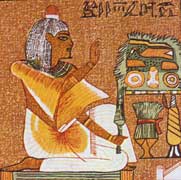
People in his novels are often like reeds in the wind.
From the Papyrus of Ani (British Museum No. 10, 470, sheets 3 and 4)
Who Was Akhenaten?
Two years later, Naguib Mahfouz published one of his most intriguing and perhaps most revealing books; his novel on Akhenaten, al-‘A’ish fi-l-haqiqa (1985), “Dweller in Truth”. Adopting the narrative method of multiple narrators, the novelist approaches a well-known enigma, the identity of Akhenaten, the author of beautiful hymns to the sun and the predecessor of Tutankhamun. King Amenophis IV, who ruled between about 1375 and 1358 BC, abandoned the dynastic cult of Amun and other gods in Thebes and left the capital, aiming to build a new one in the place now known as Tell El-Amarna. He devoted all his worship to the solar disc of Aten, the sun god, represented by rays that terminate in hands holding the signs of ankh, “the force of life”. In a similar fashion, the famous Egyptian obelisks are holy representations of sunrays.
Aten, a form of the ancient solar god Re or Ra, was hailed as the almighty, universal god. The king himself changed his name into Akhenaten, “he who is useful to Aten”, and he called his new city Akhet-Aten, the “horizon of Aten”. During his reign, Egypt was weakened by his revolutionary religious and political reforms and finally the non-belligerent dissenter was overthrown. His successor Tutankhamun (Tut-Ankh-Amun) abandoned all the reforms and reinstated Thebes as the capital. The city of Akhet-Aten was deserted and fell into decay.
At that point in history, Mahfouz’s novel begins. Some years after the fall of Akhenaten, the protagonist Meriamun (whose name deceptively reminds us of Meritamun’s mummy in the Egyptian Museum of Cairo) and his father are sailing along the Nile on a voyage from their home in Sais during the inundation. Suddenly they pass a strange city. Meriamun observes that the roads are empty, that the trees have no leaves, and that all the gates and windows are closed like the eyelids of the dead. It is completely silent. From his father he learns that this is the city of the heretical and faithless pharaoh. It is not completely deserted, though. The former wife of the deceased apostate is still living there. The foremost among Egyptian beauties, Queen Nefertiti, is living alone in the empty city, as though in a jail. The name Nefertiti means “the beautiful (one) is come”.
 |
| In the narrative stream of his short stories and novels are characters who turn up and disappear. They are figures in a greater story, or pieces in a puzzle, that is the œuvre of Mahfouz. Photo: Anders Hallengren |
Meriamun then recalls what he has heard about the whirlwind that devastated the Egyptian empire, the era called the War of the Gods, and the stories about the young pharaoh who revolted against his father, challenged the priests and fate itself. Meriamun’s curiosity grows into a passion to know the truth about the strange king. His prominent father assents, himself being “a dweller in truth”. But unlike his father, the boy has another mission: not rooted in “truth” or in any conviction as his father’s was. He starts his pursuit of knowledge, eager to find out on his own. He acts like a modern investigator, a scholar and a sceptic, a believer in science and free inquiry. It is easy, perhaps too easy, to regard him as an alter ego of the author, and his perennial pursuit of truth as a guideline to the works of Mahfouz. Nevertheless, just as Meriamun becomes eager to learn about Akhenaten, so do we become eager to know the fictional Meriamun.
Meriamun goes to Thebes to see people who knew the king, and finally he visits Nefertiti in the fallen city. This way fourteen different stories are told, and equally many versions of the truth. He interviews Akhenaten’s high priest Meri-Ra, and then we observe that Meriamun is himself named after the reinstalled god Amun. He asks the king’s mother Tiye about her son, he interrogates his secretary, the chief of the police, Nefertiti’s father, and so forth. Meriamun (or the reader) is left none the wiser. Or rather: the conclusion is that it is up to the reader to determine the truth about Akhenaten’s character, his regime and his times. Alternatively, truth is pictured as unattainable, invisible, evasive, like the person called Akhenaten and the god called Aten. These features of the god and the king are those that stand out in the variety of accounts, and perhaps one more: a dislike of warmongering.
Nefertiti, the last person interviewed, does not really know either, but says her former husband was assassinated. (He thus met with the same fate as Anwar al-Sadat, the late pharaoh the king identified with in the novel Before the Throne.) She looks forward to see her beloved in the next life, reuniting with him forever, and she hopes to sit at his dear side at the Throne of Truth. Akhenaten will thus be exalted as Osiris, the Supreme Judge in Before the Throne. As Meriamun observes, the way to truth in this world is without beginning and end, since those who are drawn to eternal truth will always extend it. Consequently, history is without beginning or end, like the existential Hikaya bi-la bidaya wa la nihaya, the 1971 story without beginning or end.
Meriamun afterwards tells everyone he knows about his investigations, and what various people have told him, but two things he discloses only to us: his increasing admiration of the hymns to the one and only God, and his love of the beautiful Nefertiti. In these concluding words of the novel, one may sense a combined veneration of literary and religious values, deference to the sublime, the invisible and unattainable, be it Allah (the one God) or the truth of humankind or that of any single individual. They all harbour the mystery of Aten and Akhenaten.
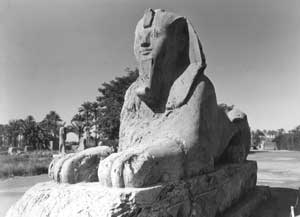
Mahfouz explored ancient Egyptian history to identify his own country in the spacetime of his existence and the sphere of his Self.
Photo: Anders Hallengren
Like Osiris, Mahfouz examines and assesses the standards of Egyptian rule, life and manners. Just as at the court of Osiris, Isis, and Horus, there are a number of questions and responses, but we are left without answers. The author’s quest is a pursuit without end.
* Anders Hallengren (b. 1959) is an associate professor of Comparative Literature and a research fellow in the Department of History of Literature and the History of Ideas at Stockholm University. He has served as consulting editor for literature at Nobelprize.org, and is editor-in-chief of TFL, the Swedish University journal of literary research.
Dr. Hallengren has been a visiting fellow in the Department of History at Harvard University, and a visiting professor in the Department of Philosophy, University of Hawaii. He has lectured in many countries, including the USA, Canada, Russia, China, India, and South Africa. As a travelling foreign affairs journalist during the term of Mohamed Anwar al-Sadat, he became deeply interested in Egyptian history and Arabic culture.
First published 16 October 2003
Nobel Prizes and laureates
Six prizes were awarded for achievements that have conferred the greatest benefit to humankind. The 14 laureates' work and discoveries range from quantum tunnelling to promoting democratic rights.
See them all presented here.
